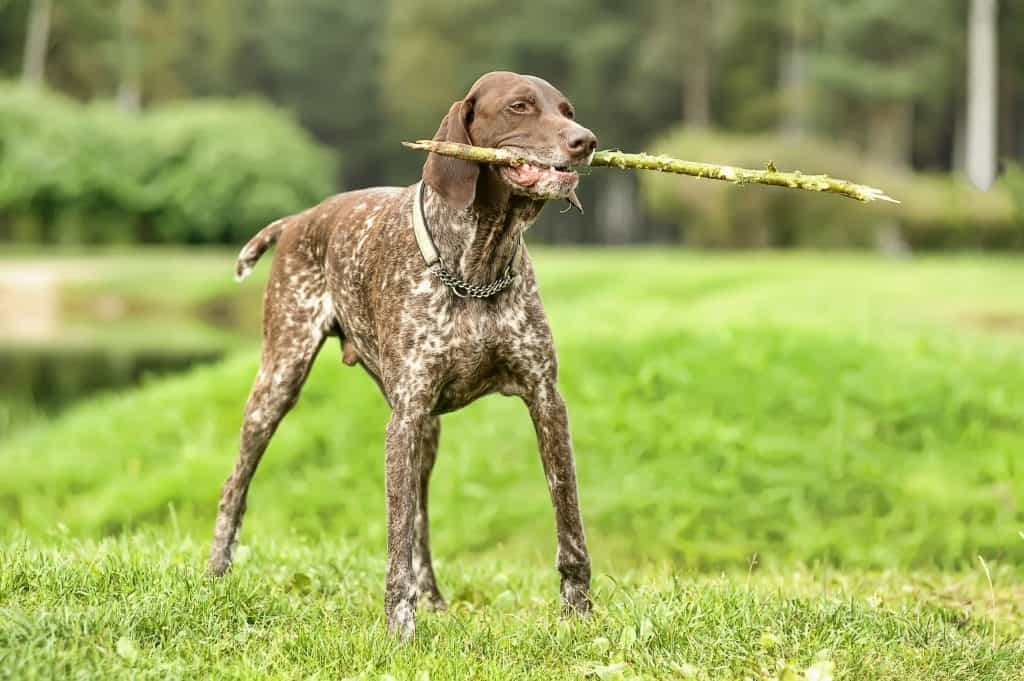How to Get Pointers to Calm Down?
Pointers are high energy dogs, and many owners take to the internet to learn how to get their pointers to calm down. A pointer’s exuberance is as much endearing as it is exhausting.
How to Get Pointers to Calm Down?
Exercising your pointer multiple times a day will help them to calm down. Additionally, consistent training and establishing boundaries will help redirect their negative energy into more positive outlets.
Pointers are naturally energetic and need some work to calm down. Having a calm pointer is not an impossible task and there are many ways to ensure that you have a happy relationship with man’s best friend. Don’t despair, we can help you!
Having a Calm Pointer
Pointers have levels of exuberance that rival the most energetic 5-year-olds. These pups are happy, carefree, and congenial dogs that people love to be around. The problems come when an owner has an energetic pointer running circles around their house, jumping around, chewing, and barking.
It can be stressful to have a dog that causes problems in the home. It’s important to know that pointers are not doing it on purpose. It’s sometimes the only outlet they have for built up energy they have naturally.
A pointer’s level of calm is always going to directly correlate to their level of activity each day. Pointers require vigorous exercise each day to help them spend the energy they always have. Pointers become terrific house pets when they get the care and exercise they require.
A pointer loves to cuddle, but they won’t be very pleasant if they don’t find a way to expel their energy first. Energy can build up in pointers and can quickly cause them to become destructive.
It’s like each night their fuel reserves fill back up and they start the next day with just as much energy as the day before. It’s just a fact of life when living with a pointer.
They’re not aggressive or mean, but excess energy combined with boredom is not good. You can often find them digging holes in your backyard, barking at everything, and chewing up anything in sight.
What they need is an outlet that you must provide them.
The History of Pointer Energy
I’ve always thought that it was important to know the history of something to really understand a current situation. The same can apply for dog breeds and their personality, temperament, and general disposition.
Pointers are a breed of dog that is known for their high energy levels. The pointer has always been bred to be a hunting dog. They track prey and then “point” them for their owners.
This particular ancestry means that they require the ability to run around all day tracking prey to be successful in their roles. They wouldn’t be able to do this if they didn’t have high energy levels, significant endurance, and amazing agility.
These facts do not just go away when you take them in and have them as regular indoor family pets. They just have been bred to have a lot of natural energy!
Take the border collie for instance. They were always bred to be sheep/herding dogs. A lot of families with border collies today do not have any need for them to herd anything (maybe except the children). This does not stop them from herding things, other animals, and people naturally.
It’s a big part of who they are and what their ancestors have always done. It’s ingrained into their DNA and there’s not much we can do about it. A pointer’s energy runs along the same lines. They have always needed that energy in the past and owners will now have to adapt to that fact.
In a home, they aren’t always getting the opportunity to go outside and chase birds full speed to their heart’s content. They are usually cooped up for most of the day while their owner’s work.
Even if they are left in a fenced in backyard for the day, being cooped up and bored can cause that constant buzzing of energy, fueled by their need to run, chase, and stretch their muscles, to build up and bubble over.
This is when they tend to channel that energy into less creative outlets. They chew and bark, and dig.
Exercise and Recovery Time
Exercise is the key to calming down a pointer. They are superb athletes and need to be treated as such. Even if your pointer isn’t going to become a hunting companion for you, you need to dedicate time every day to their exercise.
You never know how much is going to be enough each day, so be prepared to practice some patience. “Patience” is a word often used when referring to pointers and their training.
Tossing a ball in the backyard is rarely going to be enough to get your pointer calm. You need to take them on runs, bike rides (you on the bike with your pointer running alongside you), or let them loose to wander big open fields away from noise and distractions.
Don’t get me wrong; fetch is a very important game. Pointers are slightly more complex than some other, less athletic, dogs are. The really need intense physical exercise combined with some good mentally stimulating games.
You want your pointer to have time to problem solve and think. This can really help them feel content and calm once they’ve worked out their bodies and their brains.
Some owners suggest playing some fetch before taking your pointer out to run to help them focus and be easier to handle. This isn’t going to be a “one and done” kind of thing if you want a happy and calm pointer.
You’re probably going to need to do some sort of exercise multiple times a day. Many pointer owners discuss taking their pointer out to exercise once in the morning and once in the evening.
Something that isn’t always discussed when talking about exercising your dog, but is an important aspect, is allowing time for recovery. After a run or other intense exercises, you’ll always want to give your dog 20-30 minutes to recover.
This is especially important if going from fetch to a run right after. This can help regulate your dog’s energy without pushing them too far.
Remember to always check on your dog whenever you’re exercising. They will run for you forever if they have to. It’s your job to notice their sudden drop off in energy, falling behind you, and heavy panting.
Always give your pointer plenty of water even when out in the middle of a walk or run. Dogs typically need just as much, if not more, water as we do.

Training for a Calmer Pointer
Pointers are pretty stubborn, but they are very intelligent and are very trainable. The key to almost every aspect of a pointer’s life is how well they’re trained.
You should start training your pointer at 8 weeks old if possible. It’s important for them to know basic obedience early in their lives to establish boundaries, expectations, and who’s in charge.
You can also train your pointer further for hunting, but, all in all, life is always happier when your pointer is trained.
Having a trained pointer can also help keep them calm. Even a pointer overflowing with energy, if well trained, will try to respond to their owner’s command as best they can.
If you have control over your pointer then their exuberance won’t seem impossible to handle. Having a well-trained pointer is also a good idea because it can help you transition them going from the house to a run, and it can help you have more control when you’re out with them on a leash.
There are many benefits to having a trained pointer, but the most important is that you have some control over them which can generate a calmer demeanor before you are able to exercise them.
A pointer’s high energy is apart of owning one. There is no way to take it away, but there are plenty of great ways to maintain it. This is why pointers are recommended for more experienced and active owners.

It’s much easier to incorporate a pointer into your active lifestyle than to adapt your lifestyle to match.
